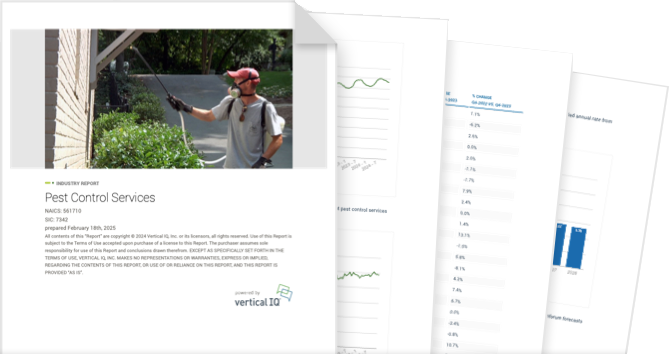Residential Building Contractors NAICS 2361

Unlock access to the full platform with more than 900 industry reports and local economic insights.
Get access to this Industry Profile including 18+ chapters and more than 50 pages of industry research.
Industry Summary
The 207,400 residential building contractors in the US build single and multi-family homes (condos and townhouses) and provide remodeling services. The majority of new single-family homes are speculative homes, in which the contractor owns the land and begins construction without a sales contract. Contractors that build speculative homes are known as operative builders. About 78% of residential building contractors are solo operators.
Reliance On Credit Markets
The availability of credit affects potential buyers’ ability to secure a mortgage and contractors’ access to capital.
Reliance On Subcontractors
Residential building contractors rely on subcontractors for a high percentage of work.
Recent Developments
Dec 17, 2025 - Top Home Improvement Players Notch Tougher Q3
- Home Depot and Lowe’s faced headwinds in the third quarter as housing market weakness and economic uncertainty dampened home improvement demand, according to Retail Dive. Home Depot’s net sales rose 2.8% over Q3 2024, boosted by its $900 million acquisition of GMS, but net income fell 1.3%. Comparable sales were nearly flat. Lowe’s reported a 3% year-over-year sales increase, with gains in pro sales, home services, and online purchases, though net income fell 4.7%. Both retailers cited weaker demand for large discretionary projects and revised their outlooks downward. Each continues to target professional customers, with Home Depot acquiring GMS and Lowe’s planning to acquire Foundation Building Materials. The sector remains pressured by cautious consumers and limited housing activity.
- Home builder confidence in the single-family market increased in December but remained solidly in negative territory as builders face ongoing headwinds, including high construction costs, tariffs, and economic uncertainty, according to the National Association of Home Builders (NAHB). Home builder sentiment, as measured by the NAHB/Wells Fargo Housing Market Index (HMI), rose one point to 39 in December 2025. Any HMI reading over 50 indicates that more builders see conditions as good than poor. Builder confidence readings remained below 50 for every month in 2025 and were in the high 30s in the fourth quarter. The HMI survey also showed that 40% of builders reduced home prices in December to lure potential buyers off the sidelines, and the average price reduction was 5%, down one percentage point from November.
- Weak rent growth and absorption in the multifamily market may signal a slowdown in apartment construction. Multifamily properties saw distress climb to 10.8% in November, up 50 basis points, as floating-rate debt and rising expenses pressured the sector, according to CRED iQ and reporting by Multifamily Dive. The increase followed months of improvement in apartment CMBS loans, which had dropped 270 basis points from March to October, though Trepp reported delinquencies eased to 6.98% in November after briefly topping 7%. Overall commercial real estate distress reached 11.63%, with offices leading at 17.55%, hotels at 10.33%, and retail at 9.08%. CRED iQ warned investors with multifamily and office holdings to monitor exposure, noting nearly 60% of distressed loans stem from maturity defaults. Analysts say adaptive reuse could provide relief, with rising office and hospitality delinquencies creating opportunities for conversions into housing.
- President Trump’s tariffs and immigration crackdown are straining US homebuilders, raising costs and worsening labor shortages, according to The New York Times. Builders face higher prices for steel, copper, lumber, and other materials, with tariffs adding up to $10,900 to the cost of a typical home, according to the National Association of Home Builders. Immigration enforcement has made workers fearful, delaying projects and shrinking crews. Construction added only 6,000 jobs through August, despite an Associated Builders and Contractors projection that nearly 500,000 more workers will be needed in 2026. Builders are slowing activity, cutting budgets, and bracing for slower growth as high mortgage rates and weak demand are dragging down sales. Economists warn that even if interest rates fall, labor and material pressures could intensify.
Industry Revenue
Residential Building Contractors

Industry Structure
Industry size & Structure
The average residential building contractor employs 5 workers and generates about $2.9 million in annual revenue.
- The residential building contractor industry consists of about 207,400 companies that employ about 943,100 workers and generate $599 billion annually.
- An additional 839,793 solo-practitioners generate $86 billion annually.
- Remodelers account for 62% of establishments; single-family general contractors are 27%; operative builders are 9%; and multi-family contractors are 2%.
- While residential construction includes private and public projects, the vast majority of work is in the private sector.
- About 80% of residential building contractors employ fewer than 5 workers and together cover 20% of the industry's payroll. Less than 1% of establishments are very large, employing over 500 workers each and together cover 18% of industry payroll.
- Large companies include D.R. Horton, Pulte Homes, Lennar Corporation, NVR, and KB Home.
Industry Forecast
Industry Forecast
Residential Building Contractors Industry Growth

Vertical IQ Industry Report
For anyone actively digging deeper into a specific industry.
50+ pages of timely industry insights
18+ chapters
PDF delivered to your inbox
